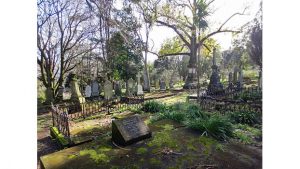Explore Auckland’s oldest cemetery
According to Heritage New Zealand’s Mid Northern Regional Archaeologist, Bev Parslow:
“People looking for green space, some fascinating history and a pleasant walk will enjoy exploring a historic burial ground like Auckland’s Symonds Street Cemetery,” says Bev.
“As well as providing an oasis of calm away from the bustle of everyday life, the cemetery also enables people to reconnect with our shared history through a fascinating lens.”
Symonds Street Cemetery is a recorded archaeological site and is one of our oldest urban cemeteries – possibly the earliest established under direct colonial government control.
“The cemetery is one of Auckland’s most important archaeological sites due, in part, to the nature, scale and variety of its physical remains and as a the earliest surviving establishment yet recognised in the colonial capital of Auckland,” says Bev.
“It is essentially the same age as Auckland itself – and that’s reflected in its layout, and the people who are buried there.”
The location and layout of the Symonds Street Cemetery differed from earlier graveyards in New Zealand at that time, which followed the traditional British model of burial in churchyards. The Symonds Street Cemetery reflected greater egalitarian sentiments by the establishment of the initial burial ground as a General Cemetery – for the burial of all inhabitants irrespective of religious denomination.
While physical separation from the main population centre was partly a response to prevailing concerns about the effects of burial grounds on public health, it also reflected the influence of broader Enlightenment ideas on the new colony, which stressed the separation between church and state.
It wasn’t long, however, before the cemetery became split into different areas based on religious or denominational break-down – including Anglican, Catholic, Methodist and Jewish sectors.
“This religious diversity makes for a really interesting walk,” says Bev.
The Anglican sector, for example, is characterised by traditional English trees like oaks which symbolise Englishness and stoutness of resolve. The meandering footpaths also make for a picturesque backdrop.
“The Catholic part of the cemetery by contrast has an ordered, linear layout possibly reflecting the influence of French Marist missionaries in Auckland who would have been influenced by the reformation of French cemeteries in 1808,” says Bev.
The mortuary monument and markers, in-ground remains such as graves and burials; visible landscape features such as walls, paths, earthworks; and stand-alone structures like the Centennial Memorial Chapel and Mortuary Building, historical plantings and botanical remnants form part of the archaeological landscape of the cemetery.
All of these elements are inter-connected both physically and in their ability to demonstrate the historical evolution of the cemetery.
“Systematic archaeological recording of these features provide information about issues as diverse as religious observance, funery practice, ethnic and other origins, trade and technology, public health and attitudes toward commemoration and death,” says Bev.
“The Symonds Street Cemetery tells us a lot – and also reflects changes in society over time.”
Besides the diversity of its layout, walkers can seek out the final resting places of some key figures in New Zealand history – including Governor William Hobson, who oversaw the signing of the Treaty of Waitangi, and Baron Charles De Thierry who had extensive land claims in Northland and hoped to establish himself as ‘sovereign chief’.
“Ironically his grand designs were ultimately thwarted by the signing of Hobson’s Treaty at Waitangi in 1840,” says Bev.
“These figures were key personalities in the formation of early New Zealand, and it’s quite interesting to think that they’re buried close to each other.”
Besides famous people in history, the cemetery is also the final resting place for many of Auckland’s earliest settler families.
“Symonds Street Cemetery is an important archaeological site in its own right – it is scheduled A in the Auckland Council District Plan and listed with Heritage New Zealand as a category 1 Historic Place,” says Bev.
“It has great significance for Aucklanders, and is well worth exploring.”
Other historic cemeteries in Auckland include Waikumete and Purewa.
For more information on the Symonds Street Cemetery - http://www.heritage.org.nz/the-list/details/7753












Comments are closed.